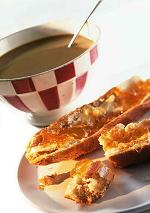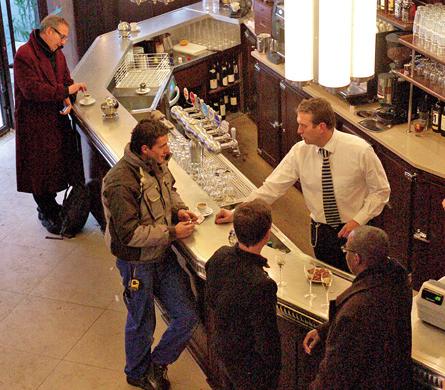How to order coffee in Paris
 Monday, May 3, 2010 at 9:57AM
Monday, May 3, 2010 at 9:57AM  It would seem that in the past couple of decades, America, Canada and the UK have caught up with the rest of the world, namely Italy and France with their understanding and taste in coffee. One notable exception seems to have been Australia. Even when I was living there in the 80s you could get a good Italian style coffee drink at any corner milk bar or sandwich shop.
It would seem that in the past couple of decades, America, Canada and the UK have caught up with the rest of the world, namely Italy and France with their understanding and taste in coffee. One notable exception seems to have been Australia. Even when I was living there in the 80s you could get a good Italian style coffee drink at any corner milk bar or sandwich shop.
Out went the dishwater-bland over perked coffee our parents and grandparents favored for the rich, dark roasted coffee that comes in a dozen forms. In the US and UK, the point of reference for naming coffee drinks is Italy. We have all become familiar with the words Cappuccino, Latte, Espresso and the like. So today, an American or Brit travelling in Italy can order coffee in Italian like a native. For the same reason, I’ve always felt a certain comfort going to Italian restaurants in countries where I don’t speak the language. Because, even in the furthest reaches of Anatolia for example, the menu is in “English”. Well, it’s actually Restaurant Italian which simply seems like English. Who wouldn’t feel comfortable seeing the words Lasagne or Spaghetti Bolognaise on a menu in Turkish.
Well, in Fance, things aren’t often as easy. As my good friend J always says “Those French, they’ve got a different word for everything” and this is certainly true for coffee. So here’s a quick primer on how to get a satisfying cup of Joe just like you enjoy on your way to work back home.
The first thing to forget is the Café au Lait. This is what many people seem to associate with coffee in France, but no Frenchmen are ordering this in their local café. The closest thing is a Café Crème which comes in two sizes, one called a Café Crème and the larger a Grand Crème. This is a steamy combination of espresso coffee and steamed milk topped with foam – much like a Cappuccino. For those of you that prefer a drip style coffee, there is the Café Allongé. This is espresso diluted with hot water. Sorry, but aside from a few hotels, real drip coffee is only made at home here. If you like drip coffee with milk, and I’m sure you do, then you have to ask for it. You’ll say “Café Allongé avec du lait à coté” – Cafe ah-longe-ay ah-veck doo lay ah co-tay. If these seems too complicated, you’re right. I say unless you drink your coffee black, stick with a Café Crème.
After that, if you only know one French word for coffee you’ll probably order a Café and perhaps be disappointed when you are served a tiny espresso. But here’s where it gets complicated, or for some of you -- interesting. Like nearly everything in this food obsessed culture, there are rules about coffee. Just like the rules for cutting the cheese or what to serve at a dinner party that I've written about before. Okay, these are not really rules, but more like cultural expectations.
 The big milky coffees favored by Americans are only drunk in France for breakfast. At home, morning coffee is usually from a bowl, not a mug. This makes it easier to dunk the leftover baguette bought for dinner the night before into your coffee. Yes, besides the idea of ordering café au Lait, the idea that Frenchman head out merrily each morning to buy a baguette is also something of a myth. Sure, people head out to buy croissants on the weekends and perhaps the odd occasion when they want to impress someone new who’s spent the night.
The big milky coffees favored by Americans are only drunk in France for breakfast. At home, morning coffee is usually from a bowl, not a mug. This makes it easier to dunk the leftover baguette bought for dinner the night before into your coffee. Yes, besides the idea of ordering café au Lait, the idea that Frenchman head out merrily each morning to buy a baguette is also something of a myth. Sure, people head out to buy croissants on the weekends and perhaps the odd occasion when they want to impress someone new who’s spent the night.
After about 10am, most people have switched to café (espresso) and after a meal they'd never ever order a big milky coffee. I’m not sure what comparison to make to define the puzzled look sometimes seen on waiters’ faces, but it’s akin to ordering a bowl of cereal for dinner anywhere but a 24-Hr Diner. When you think about it, having a big steaming mug of hot milk with a small dose of espresso after a three course French lunch with wine and cheese does seem a bit strange, if not a bit hard to digest. But who knows, maybe I’ve just gone native.
“Hey, wait a minute” I hear you saying, “I hate coffee without milk.” Well so do I. So here’s a trick to order like a local and still get a really nice mid-day or post-meal coffee. Order a “Noisette”. In French, Noisette (Nuh-wah-zet) means Hazelnut and might refer to the color of the coffee. It is also a cooking term used in recipes to describe a small amount of butter. In the UK they say “add a knob of butter” where the in French one says “ajoutez une noisette du beurre” so who knows. Besides, we need to order a coffee.
A Noisette is an espresso, with a dollop of foamed milk and a tiny bit of milk. Just like a Macchiato in Italy or a Café Cortado in Spain. In better restaurants and some cafés they bring you an espresso with a tiny pitcher of milk so you can make your own blend – my personal favorite.
 That covers the options for what to order, but budget conscious visitors will be interested in one further tip. When you are in an average neighborhood café in Paris, you have three options where you can order and consume your coffee. Outside on the terrace, inside at a table or at the counter. “Au Bar”. The prices are different between the bar and the tables. A simple Café is 2.50€ or more when served at a table, but rarely more than 1.20€ at the bar. Often 1€. So if you want to have a quick coffee break and save money, order and drink at the bar. It’s also the fastest way to use the restroom without any hassle, if you are having trouble finding one. This applies to all drinks, so you can have a budget aperitif at the counter as well. If you are unsure if the café you've entered serves at the bar, look for the tell-tale sugar bowls set out on the bar to indicate they serve coffee there. After all, coffee without sugar is as unthinkable in France as coffee without milk in the states.
That covers the options for what to order, but budget conscious visitors will be interested in one further tip. When you are in an average neighborhood café in Paris, you have three options where you can order and consume your coffee. Outside on the terrace, inside at a table or at the counter. “Au Bar”. The prices are different between the bar and the tables. A simple Café is 2.50€ or more when served at a table, but rarely more than 1.20€ at the bar. Often 1€. So if you want to have a quick coffee break and save money, order and drink at the bar. It’s also the fastest way to use the restroom without any hassle, if you are having trouble finding one. This applies to all drinks, so you can have a budget aperitif at the counter as well. If you are unsure if the café you've entered serves at the bar, look for the tell-tale sugar bowls set out on the bar to indicate they serve coffee there. After all, coffee without sugar is as unthinkable in France as coffee without milk in the states.
One last tip for ordering coffee in a Café, if you arrive around lunchtime and only want to have a coffee on the terrace, choose a table that is not set with silverware and glasses. Those tables are reserved for people eating, not drinking coffee. So you will likely be shooed away. The same is true in the evening when you might like to have an aperitif on the terrace. But if most of the tables are empty, just ask and they will often let you sit there.
Glossary
English / Italian French What to say Prononced
Espresso Café Café Ca-fay
Cappucino Café Crème Un Creme Uhn Khrem
Macchiato Noisette Une Noisette Eywoon Nuh-wah-zet
Tartine photo credit - Croque Madame
How to order coffee in Paris
 Christopher
Christopher
What about Decaf?
Since I wrote this post, I have often been asked this question. Well in France people also drink decaffinated coffee, especially in the late evening after a long meal.
So all of the same "rules" apply as I discussed in the earllier post. The only thing you need to know is how to ask for one. The word for decaffinated is décafiné. Pronounced dey-ca-fee-nay. It is usually shortened to Déca, deh-kah, when ordering.
Hence, all you need to say is Déca Creme, Déca Noisette, Déca Allongé or if you want a decaf espresso simplysay "un déca."
Et voila - the mystery of decaf in Paris solved...
 Coffee in
Coffee in  Food,
Food,  French Culture,
French Culture,  Practical Paris
Practical Paris 
Reader Comments (3)
Good information! But how do you ask for a coffee "to go?"
wonderful post and a bit comedic as well. Love your post about cutting cheese as well.
Hi. I liked your article. However I just came back from France last week and spent a week in Paris and a week in Normandy and the Loire Valley.
Just a couple minor deviations from the article that I witnessed. Firstly. An allongé coffee or café allongé is actually espresso that has been pulled a bit longer than a regular espresso. This allows more hot water to flow through the coffee grinds and gives a less intense but more bitter flavour and produces a larger drink. An americano is espresso with hot water added.
Second. I spent a few days and nights in the smaller villages outside of Paris and frenchmen do go out and buy fresh baguettes merrily in the morning. I saw both men and women doing this and it seems to make sense since that is when they are freshest and they haven't run out as they tend to do by the late afternoon.